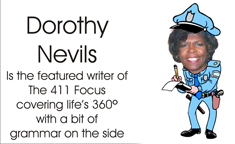
Today, I shall march boldly into the "punctuation puddle" where it almost seems that no one has ever gone before!
Contributed By:Dorothy Nevils maslivend@sbcglobal.net
Grammar Patrol: Change? Never!
Do you have stuff around your house or in your garage that needs to be tossed? Yet you hang onto it. You’ve had it so long that it “just feels right.” You should have shaken off the attachment, but your will power is just gone to jelly, or it’s melted like an ice cream bar in a 2-year-old’s hand on a super hot day. You just can’t bring yourself to part with this long-lived nothingness, though folks, including me, have to wrestle it from your grip for years! It’s as if you’ll roll up into a ball and die!
The thing that a lot of folks hang onto is poor grammar. Though nobody sat you down for a period of time and insisted that you write or speak contrary to accepted language, you feel it’s your heritage, and turning your back on it is like betrayal. Perhaps you still can’t stand your English teacher for trying to turn you into a traitor.
Well, I’ve weathered a few unholy looks, and I still feel obligated to change bad habits, one broken piece at a time. Today, I shall march boldly into the “punctuation puddle” where it almost seems that no one has ever gone before! Let me pull on my running shoes (It’s dangerous territory!) and start with comma splices.
You know what splice means, right? When I studied radio and TV, there were those really big reels of tape, and if they were torn or cut, or if sections of recording had to be rearranged, the part that was no longer useful was cut out at an angle, and the ends taped together.
In English, comma splices were the scourge. Often called run-ons because, instead of stopping and signaling the rest of the sentence, it just raced on like a squirrel in the road when the recycling truck comes. In fact, in earlier grammar books, any sentences that were not properly punctuated as two independent messages were called run-ons. Personally, I think throwing them in the same dirty clothes basket makes more sense, but, as the saying goes, “It is what it is!”
Punctuation marks are like traffic signals. Can you imagine what traffic would look – or sound – like with no control? There’d be accidents galore, and a lot of anger!
The same thing happens – well, “sorta” – in communication. People can generally pick their way through and figure out what the writer is saying, but that is not the reader’s job! Punctuation marks are symbols, like postings along the highway, to help the reader get the message. The writer’s job is to send a clear and concise message that won’t take the reader eons to decipher!
So, how can you tell if you’re writing two sentences as one? Do a simple test. If the writer uses a comma, place a slip of paper right behind the comma. If the part you see is a whole sentence, then take the paper up and place it over the front part. If the last part is also a sentence, you have a comma splice, or an old-fashioned run-on sentence.
More and more, comma spices are becoming the “in” thing. Journalists for well-respected newspapers are guilty, and that’s something that just wasn’t ten or twenty years ago! The standards have slid so low that people who, a few years back used the language easily, now don’t trust themselves. Professional writers, whom they trusted, now commit the same errors that got “red-lined” years ago.
I think it’s the electronic age that’s let all this sloppy English take root. People are all over social media writing “Thank you, I appreciate that,” and “I’ll see you when you get back, have a nice time,” so that people would not recognize a sentence if it crawled into their beds!
I’ll tell you this: Don’t expect things to get any better. Standards have fallen so far that, like a crystal goblet dropped from the 23rd floor, what it used to be is no longer recognizable!
Story Posted:10/07/2017
|